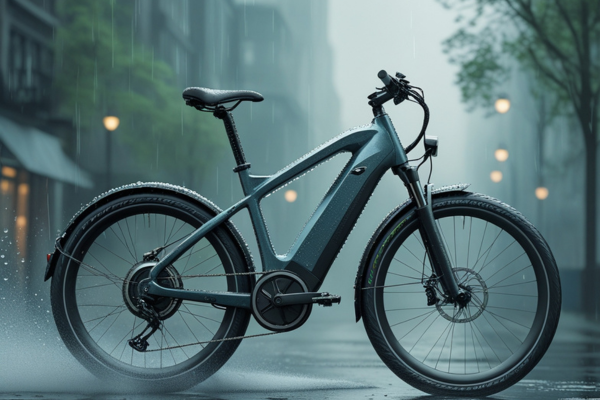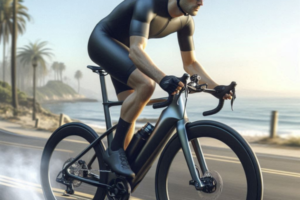🌧️ How Humidity Affects More Than Just Comfort
When we think about the challenges of riding an electric bicycle in humid environments, our minds often go to battery life or motor protection. But there are two other essential aspects that are directly and silently impacted by high humidity: braking performance and aerodynamics. These elements affect not only how smooth and efficient your ride is, but also how safe and responsive your e-bike can be when it matters most.
Humidity may seem harmless—just moisture in the air. But in coastal areas or tropical cities where relative humidity regularly exceeds 75%, its effect on air density, friction, heat dispersion, and mechanical responsiveness becomes significant. And while the changes aren’t always visible, they add up quickly in the form of delayed braking, reduced control, or increased drag.
This first block explores why understanding the relationship between humidity, braking efficiency, and aerodynamic resistance is key to improving your riding experience and staying safer on the road. Let’s begin with how water in the air interferes with one of your bike’s most vital systems: the brakes. 🛑
🛠️ The Impact of Humidity on Brake Response
High humidity affects braking in both mechanical and electronic braking systems. Here’s how:
- 💧 Brake pads absorb moisture: This leads to reduced friction and delayed stopping, especially in the first few seconds of braking.
- 🌫️ Condensation on brake rotors: Causes a thin water film that reduces grip until it evaporates through friction.
- 🧪 Humidity-induced rust: Prolonged exposure to moisture can corrode metal components like calipers, levers, and cables.
- ⚡ Sensor inconsistencies: In hydraulic or electronic systems, humidity can interfere with sensor signals or cause seals to swell.
In simple terms, what should be an instant response becomes sluggish. In emergencies, this delay—even if it’s just a second—can make a major difference.
📊 Table: Brake Response – Dry vs. Humid Conditions
| Condition | Brake Pad Grip | Reaction Time | Risk Level |
|---|---|---|---|
| Dry, low humidity | High | Fast (instant) | Low |
| Humid, 80% RH | Reduced | 0.5 to 2s delay | Moderate |
| Post-rain, foggy | Very Low | Significant delay | High |
🧠 Visual Comparison: The “Wet Paper” Effect
Imagine trying to stop a wheel using dry sandpaper versus soggy cardboard. That’s the difference between braking in dry and humid conditions. Moisture reduces surface friction and softens the materials involved. If your brake pads are even slightly damp, they may slide instead of bite.
💡 Quick Tip: After parking outdoors overnight, always do a short brake test before entering traffic. If there’s resistance or a squishy feel, dry your rotors manually.
💡 Inspiration: In humid weather, braking isn’t just a reaction—it’s a relationship between your bike and the air. The better you understand it, the safer you’ll ride.
💨 How Humidity Influences Aerodynamics and Riding Efficiency
We often associate humidity with sweat and discomfort, but for e-bike riders, its effects go far beyond personal sensation. High moisture content in the air significantly influences aerodynamics—how easily your bike slices through the atmosphere—and can lead to reduced speed, higher energy consumption, and increased drag. In a coastal or tropical setting, the air isn’t just wet—it’s thicker.
Air density increases with humidity, which may sound counterintuitive, but it’s due to how water vapor replaces heavier oxygen and nitrogen molecules. This denser medium creates more resistance for riders trying to maintain momentum or accelerate. And the difference, while subtle per meter, becomes very noticeable over longer distances or at higher speeds.
🌫️ The Science of Drag in Humid Conditions
Aerodynamic drag is the force that resists your movement as you ride forward. It’s influenced by several factors: speed, frontal surface area, and—crucially—air density. The more humid the air, the more “pushing” you must do to maintain your pace. Here’s what this means for your performance:
- 📉 Reduced top speed: In humid conditions, riders may lose up to 10% of their maximum speed due to increased resistance.
- 🔋 Increased battery consumption: Your motor works harder to maintain speed, reducing range per charge.
- 🌀 Greater wind resistance on accessories: Items like baskets or panniers catch more drag in heavier air.
- 💨 Harder pedaling for non-motorized moments: Coasting becomes less effective; you feel like you’re riding into a constant breeze.
📊 Table: Aerodynamic Drag by Climate Type
| Environment | Air Density | Drag Force (At 25 km/h) | Battery Efficiency |
|---|---|---|---|
| Dry, temperate | 1.20 kg/m³ | Low | Optimal |
| Humid, 85% RH | 1.24 kg/m³ | Medium | Reduced |
| Coastal, foggy | 1.27 kg/m³ | High | Significantly reduced |
🧠 Visual Comparison: Riding Through Soup vs. Air
Picture yourself walking through a swimming pool versus walking in open air. In humid environments, the air behaves more like a thin liquid—offering more resistance to your movement and reducing efficiency with each push. That’s what your e-bike experiences when the air is saturated with moisture.
💡 Smart Tip: If you ride regularly in humid conditions, consider lowering the frontal profile of your gear, streamlining your accessories, and using breathable clothing to reduce drag.
💡 Inspiration: In heavy air, the rider who knows their resistance can go further with less force. Knowledge is your new tailwind.
⚠️ Common Mistakes That Compromise Performance in Humid Climates
Riders often underestimate how subtle environmental factors like humidity can influence braking and speed. Unfortunately, that underestimation can lead to poor habits or maintenance choices that reduce safety and efficiency. The good news? Once you recognize these mistakes, they’re incredibly easy to fix.
In this section, we’ll explore the most common errors made by e-bike riders in humid regions and how to correct them. Whether you’re cruising through coastal fog or navigating tropical rain, avoiding these missteps will help you ride smarter and safer. 🧠
🚫 Most Frequent Mistakes in Braking and Aerodynamics
- 🧴 Neglecting to clean brake rotors after rain: Salt or moisture left on rotors can corrode the surface and reduce stopping power.
- 🪫 Assuming electric braking is immune: Even regenerative or electronic braking systems rely on sensors and wiring that can be affected by moisture.
- 🎒 Overloading the front end: Adding baskets or high-mounted accessories increases frontal area, increasing drag.
- 🚫 Using the wrong clothing: Loose or flapping garments increase air resistance and reduce cooling efficiency.
- 🧽 Cleaning with harsh chemicals: Products not designed for e-bikes can strip protective coatings on brakes or wiring.
📊 Table: Mistake vs. Consequence
| Mistake | Short-Term Effect | Long-Term Risk |
|---|---|---|
| Wet brake rotors | Delayed response | Corrosion, noise, reduced lifespan |
| Poor gear aerodynamics | Lower speed | Motor strain and battery drain |
| Overconfident in electronic braking | Inconsistent stops | Sensor failure in humidity |
📋 Rider’s Prevention Checklist
- ☐ I wipe down my brake components after every wet ride
- ☐ I check my cables and sensors monthly for moisture signs
- ☐ I reduce front-end drag by lowering or streamlining loads
- ☐ I wear form-fitting, breathable clothing in humid weather
- ☐ I use only e-bike safe cleaners and lubricants
🚨 Prevention Tip: If your brakes make unusual noises or your ride feels slower than usual, don’t assume it’s just your imagination. It could be humidity affecting friction or airflow.
🔁 A Quick Visual: Braking with Foggy Glasses
Braking in a humid environment is like trying to read street signs with fogged-up glasses. It works—barely. But it’s slower, less reliable, and more stressful. Cleaning and prep give you clarity, responsiveness, and confidence.
💡 Reflection: Don’t let the invisible forces of humidity control your ride. Take the small steps today that make the big difference tomorrow.
🧰 Prevention Routine: How to Stay Ahead of Humidity’s Effects
After identifying how humidity affects your braking and aerodynamic efficiency—and the common mistakes riders make—the next step is turning that knowledge into action. A well-designed maintenance and inspection routine doesn’t have to be complicated or time-consuming. It just needs to be consistent and adapted to your climate.
Especially in coastal or tropical areas, where moisture and salt particles constantly interact with your components, a prevention habit can protect your investment, improve your performance, and boost your confidence on the road. Let’s walk through how to create a humidity-proof care plan that actually works. 🛡️
🗓️ Weekly and Monthly Action Plan
| Action | Recommended Frequency | Why It Matters |
|---|---|---|
| Clean brake rotors and pads | Weekly | Removes salt residue and improves grip |
| Wipe motor housing and connectors | Weekly | Prevents oxidation and drag buildup |
| Inspect cables and levers for moisture | Biweekly | Catches swelling, rust, or false readings |
| Reapply silicone spray or PTFE coat | Every 3 weeks | Maintains outer layer resistance |
🧼 Materials to Keep Ready
- 🧴 Dielectric grease (for electrical connectors)
- 🧽 Microfiber cloths (for daily drying and cleanup)
- 🧪 Isopropyl alcohol (for rotor and cable cleaning)
- 🔧 Small hex key and torque wrench (for tightening brakes)
- 💨 Hand air blower or hair dryer (low heat) to dry parts post-rain
💡 Pro Tip: Store these items in a small, waterproof toolkit or saddle bag, so you can use them even during or after unexpected weather changes.
📋 Easy Prevention Checklist
- ☐ I clean brake and motor parts weekly
- ☐ I inspect and dry connectors after rain
- ☐ I reapply protective sprays regularly
- ☐ I check cable tension and brake grip monthly
- ☐ I store my bike in a dry, ventilated location
🌿 A Visual Analogy: Treat Your E-Bike Like a Living System
Just like your lungs need clean air to breathe, your e-bike needs clean, dry contact points to function optimally. When the “air” it interacts with is heavy with water and salt, it struggles—unless you create an environment where it can breathe, reset, and restore.
💡 Reflection: Consistency protects what technology alone cannot. The best riders aren’t just strong—they’re prepared.
💬 Frequently Asked Questions (FAQs) on Humidity and E-Bike Performance
Can humidity really reduce my braking power that much?
Yes. Even a small amount of moisture on the brake rotors or pads can delay stopping time and reduce friction. In high humidity environments, that moisture builds up faster—especially if the bike is stored outdoors or ridden after fog or rain.
Does humidity affect both mechanical and hydraulic brake systems?
Absolutely. Mechanical brakes suffer from corrosion on cables and springs, while hydraulic brakes may experience swelling of seals and inconsistent sensor behavior due to moisture absorption.
How can I minimize aerodynamic drag in humid climates?
Streamline your gear, reduce frontal area, wear form-fitting clothing, and keep accessories low and centered. Clean the bike regularly to remove salt buildup that can roughen surfaces and increase air resistance.
Do these issues affect pedal-only bikes too?
Yes, though not as dramatically. Any bike operating in dense, moist air will face more drag and reduced brake effectiveness. E-bikes are more affected because their systems are more complex and rely heavily on sensor-based feedback.
What’s the best place to store my bike in a humid city?
Ideally in a ventilated, covered space—not against concrete walls or directly on floors. Use a breathable bike cover (not plastic) and avoid areas prone to condensation. Elevate it slightly for better air circulation.
💖 Final Thoughts: Humidity May Be Invisible—But Your Response Doesn’t Have to Be
Riding through humid air shouldn’t mean sacrificing safety or performance. The more you understand how this invisible force interacts with your brakes, your gear, and the shape of your ride, the more confidently you’ll navigate every route.
This isn’t about fear—it’s about awareness and empowerment. Your e-bike is built to carry you far. But your care and preventive actions are what truly unlock its potential—especially when the air turns heavy, the fog rolls in, or the rain becomes routine.
Each time you clean your rotors, adjust your gear, or wipe off condensation, you’re building a relationship of trust with your machine. A ride is more than motion—it’s an expression of harmony between you and the environment. 🌍💙
💡 Inspiration: The most powerful rides don’t always happen in perfect weather—they happen when a prepared rider meets imperfect conditions with confidence.
🌎 Join the Conversation: How Do You Ride Through Humidity?
Do you live in a tropical or coastal area? Have you discovered clever ways to keep your brakes dry or reduce drag on humid days? Or maybe you learned the hard way and want to help others avoid the same mistake?
Share your story with us: 💬 What’s your go-to routine after riding in the rain? 🔧 What product has helped you the most with brake care? 🌬️ How do you adjust your gear for resistance in heavy air?
Leave a comment below and help build a knowledge-sharing community of riders who understand that weather doesn’t stop us—it inspires us to ride better, smarter, and more connected to the world around us. 🚴♀️💬



